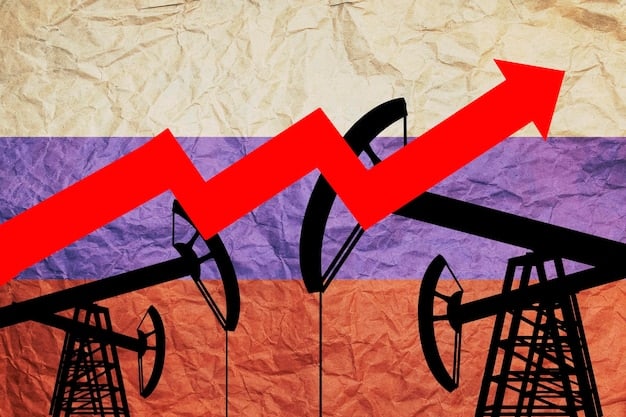Energy Sector Update: How Oil Prices Impact the US Economy

Energy Sector Update: How Fluctuating Oil Prices Impact the US Economy reveals the intricate connections between oil price volatility and its widespread effects on economic growth, inflation, and consumer spending within the United States.
The Energy Sector Update: How Fluctuating Oil Prices Impact the US Economy is a subject of immense importance and complexity, affecting various facets of American life. From individual consumers paying at the pump to businesses making investment decisions, the price of oil has far-reaching consequences.
Understanding the Dynamics of Oil Prices
Oil prices are influenced by a complex interplay of factors driven by global economics. Understanding these elements is crucial to grasping how fluctuations in the energy sector resonate throughout the US economy.
Supply and Demand Fundamentals
The basic economic principle of supply and demand plays a significant role in determining oil prices. Increased production or decreases in consumption can push prices lower, whereas higher demand or supply shortages tend to lead to rising costs.
Geopolitical Influences
Geopolitical events and instability in oil-producing regions can significantly impact global oil supply. Political tensions, conflicts, or policy changes can disrupt production and supply chains, causing price shocks and increased market volatility.

Here are key factors affecting supply and demand:
- Global Economic Growth: Strong economic growth usually translates to higher demand for oil, impacting prices upward.
- Technological Advancements: Innovations in drilling and extraction can significantly increase oil supply.
- OPEC+ Production Decisions: The coordinated decisions of OPEC+ nations significantly impact supply levels and pricing.
- Inventory Levels: Changes in oil inventories indicate changing supply-demand dynamics and influence short-term prices.
To summarize, fluctuations in oil prices are a complex interplay of supply, demand, and geopolitical forces. Comprehending these dynamics is vital for evaluating how price changes trickle down to affect various parts of the US economy.
The Impact of Oil Prices on Inflation
Oil prices have a significant, direct effect on inflation in the United States. Because oil is a necessary input for production and transportation, changes in its cost ripple through the economy.
Direct Effects on Consumer Prices
Gasoline prices are among the most visible impacts. Rising oil prices immediately translate to higher prices at the pump, impacting consumers’ disposable income. These increased transportation costs can also affect the prices of other goods that depend on trucking and shipping.
Indirect Effects on Production Costs
Many industries rely on oil-based products (e.g., plastics, chemicals). When oil prices increase, so do the costs of raw materials, leading to higher production costs. These businesses often pass these costs onto consumers, resulting in broad-based inflation.
Key ways rising oil prices impact inflation include:
- Energy Costs: Increased costs for heating oil and electricity.
- Transportation: Higher freight costs affecting the price of goods.
- Agriculture: Increased expenses for fertilizers and machinery operations, leading to higher food prices.
- Manufacturing: Greater costs for petroleum-based inputs.
In summary, the correlation between fluctuating oil prices and inflation is substantial. Changes in oil prices affect both immediate consumer expenses and the comprehensive cost structure of production through the US economy.
Effects on Consumer Spending
Changes in oil prices can drastically affect consumer spending habits. Higher prices can constrain disposable income, leading to adjustments in how families and individuals allocate their finances.
Reduced Discretionary Income
Elevated gasoline prices siphon away money that would otherwise be spent on discretionary items like dining out, entertainment, or vacations. This shift can particularly affect sectors reliant on consumer discretionary spending, such as restaurants, theaters, and tourism industries.
Changes in Spending Behaviors
When gasoline expenses rise, consumers often cut back on non-essential shopping. This can impact retailers and other businesses that depend on steady consumer demand. Conversely, when oil prices are low, consumers tend to have more disposable income, which stimulates spending across several sectors.

Impacts on Transportation and Travel
Higher prices for gasoline may incite people to adapt by using public transport, carpooling, or purchasing more fuel-efficient vehicles. These changes can have more implications, affecting car sales and the provision of public transit services.
Significant impacts include:
- Retail Impacts: Reduced in-store shopping due to higher transportation costs.
- Tourism: Reduced travel impacting hotels and recreational areas.
- Dining: Less frequent visits to restaurants as families tighten budgets.
In brief, consumer spending is highly sensitive to variations in oil prices. Increased prices can lead to decreased discretionary spending, changes in consumer behaviors, and effects on transportation and travel patterns.
The Energy Sector’s Response to Price Volatility
The energy sector itself has to navigate price fluctuations. These variations impact both exploration and manufacturing projects, as well as financial performance.
Investment and Production Decisions
When oil prices are high, energy firms are incentivized to invest in oil and gas projects, increasing development and production. On the other hand, lower prices might result in budget cuts, project deferrals, and decreased manufacturing activity, affecting the sector’s growth.
Technological Innovations
Price volatility also pushes the energy sector to innovate. Companies invest in modern technologies to lower production costs, improve energy efficiency, and tap into unproven resources.
Challenges and Opportunities
Fluctuating oil prices present both difficulties and options for the energy sector. Companies must effectively manage risks, adapt to market dynamics, and find avenues for long-term growth.
Key sector responses include:
- Efficiency Improvements: Implementing advanced methods to minimize operational costs.
- Diversification: Investing in renewable power resources to reduce dependence on oil costs.
- Hedging Strategies: Using economic devices to mitigate price fluctuations.
As a result, the energy sector responds dynamically to price volatility, balancing output, implementing modern technologies, and planning approaches to handle risks and embrace options.
Government Policies and Regulatory Impact
Government policies and regulations exert a tremendous impact on energy markets. Tax incentives, regulations, and international trade agreements help contour the reaction to changing prices.
Tax Incentives and Subsidies
Tax cuts for energy production can encourage investment and production, while subsidies can enhance the affordability of electricity for companies and households. These measures can serve to level the playing field or stimulate particular avenues of energy production.
Regulations and Environmental Standards
Environmental rules concerning emissions and drilling practices can increase the operational costs for energy firms. Nevertheless, these standards can also push improvements in cleaner energy sources and sustainable practices, shaping the long-term development of the sector.
International Trade Agreements
Trade agreements affect the export and import of oil and gas, impacting prices and overall energy security. Trade regulations can diversify energy sources and strengthen cooperation between countries.
Impactful policies include:
- Carbon Taxes: Imposing fees on carbon emissions to promote the transition to cleaner energies.
- Renewable Energy Standards: Mandating a proportion of power from renewable sources.
- Energy Efficiency Programs: Incentivizing energy-efficient technologies and practices.
Therefore, government policies and regulations have a significant effect on the energy sector, either by stimulating output, pushing modern technologies, or shaping sustainability practices.
Future Trends and Long-Term Outlook
Looking forward, several trends are expected to mold the future of the energy sector, especially in light of changing oil prices. These encompass advances in renewable power, changing regulatory dynamics, and developing consumer preferences.
The Rise of Renewable Energy
With declining expenses and increasing efficiency, renewable power sources like solar, wind, and hydroelectric are poised for more growth. Transitioning to renewable resources can decrease reliance on oil and mitigate the impact of cost volatility.
Technological Advancements in Energy Storage
Innovations in energy storage systems, such as batteries and pumped hydro, are developing the reliability and scalability of renewable energy. Energy storage solutions smooth the intermittency challenges of renewable power, rendering them an even more viable option.
Climate Change and Sustainability Goals
Growing worries about climate change are motivating greater investment in sustainable energy. Governments, businesses, and households are implementing practices to reduce carbon emissions and promote energy efficiency, reshaping the energy landscape.
Key future trends include:
- Electric Vehicle Adoption: The expanding implementation of EVs reduces the demand for oil in the transportation sector.
- Smart Grids: Enhanced grid infrastructure enables better management and distribution of electricity.
- Green Hydrogen: The development of green hydrogen as an electricity carrier offers another route for decarbonizing the power sector.
Consequently, the long-term outlook for the energy sector encompasses a shift in the direction of renewable resources, innovation in power storage, and a strengthening commitment to sustainability, minimizing the impact of cost fluctuations and ensuring a more sustainable electricity future.
| Key Point | Brief Description |
|---|---|
| 💰 Inflation Impact | Oil prices directly affect gasoline and indirectly impact production costs, influencing overall inflation. |
| 🛒 Consumer Spending | Higher oil prices reduce discretionary spending, affecting retail, tourism, and dining industries. |
| ⚡ Energy Sector Response | The energy sector adapts through efficiency improvements, diversification, and risk management strategies. |
| 🌱 Future Trends | Renewable energy, technology in storage, and environmental goals shape the energy sector’s future. |
Frequently Asked Questions
▼
Fluctuating oil prices impact consumers directly through gasoline costs and indirectly through higher priced goods and services which are driven as a result of increased transportation costs. This affects household budgets and discretionary spending.
▼
Geopolitical instability in oil-producing regions can disrupt supply, creating price shocks. Political tensions, conflicts, and policy changes in these countries cause significant volatility in oil markets worldwide.
▼
Tax incentives for energy production can spur investment and production, whereas environmental rules regarding emissions can raise operational costs. Trade agreements also control the export and import of oil, impacting domestic costs.
▼
Long-term trends signal a shift towards renewable energy like solar and wind due to falling prices and increased efficiency. Innovations in energy storage, climate change concerns, and sustainable practices also steer sector developments.
▼
The energy sector reacts to price changes through strategic investments, modern technology implementation, and improved operational effectiveness. These measures allow agencies to control risks while seizing opportunities in market dynamics.
Conclusion
In conclusion, variations in oil prices have far-reaching effects on the US economy, impacting inflation, consumer spending, and the energy sector itself. As the country transitions towards renewable energy and sustainable practices, understanding these dynamics remains vital for economic stability and future growth.





